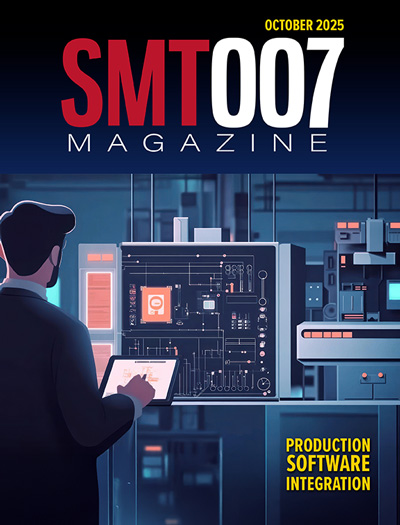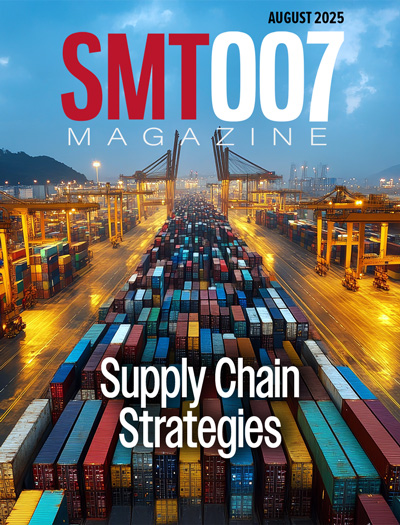-

- News
- Books
Featured Books
- smt007 Magazine
Latest Issues
Current Issue
Production Software Integration
EMS companies need advanced software systems to thrive and compete. But these systems require significant effort to integrate and deploy. What is the reality, and how can we make it easier for everyone?

Spotlight on India
We invite you on a virtual tour of India’s thriving ecosystem, guided by the Global Electronics Association’s India office staff, who share their insights into the region’s growth and opportunities.

Supply Chain Strategies
A successful brand is built on strong customer relationships—anchored by a well-orchestrated supply chain at its core. This month, we look at how managing your supply chain directly influences customer perception.
- Articles
- Columns
- Links
- Media kit
||| MENU - smt007 Magazine
Estimated reading time: 3 minutes
Operational Excellence: Hiring and Retaining Top Employees
The economy is booming, and this presents challenges for manufacturing organizations. Your top-performing employees are prime targets for competitors that are not only willing to offer a higher wage but can also offer a more attractive work environment and career growth path.
Before I dive into a strategic approach to hire top talent and retain your best employees, we need to understand the dynamics of manufacturing and labor statistics. The unemployment rate in the manufacturing industry is at its lowest in the last 15 years (Figure 1). This presents a challenge for companies to find qualified employees to fill job openings. Highly skilled employees with a strong work history are in high demand.
The Big Challenge for the Next Decade
As we look forward, economists expect a slowdown in the next few years, but the demand for skilled employees will continue to be strong. One of the expected challenges is the skill gap being created. According to one study[2] the gap between available jobs and the number of skilled workers is growing. The study estimates that there may be up to 2.4 million jobs unfilled in the next decade in the United States, with the possibility that certain skilled and managerial positions will become almost three times harder to fill than they are now. In preparation for this challenge, leading companies are taking mitigation steps to retain their top employees and creating a company culture that is attractive to draw prospective employees into the organization.
Hire the Right Talent, Not the Best Talent
The natural inclination is to always hire the best available talent for a given role. This approach makes the most sense in theory but may not yield the expected results in practice. Before making a decision to hire a candidate for an open position in your organization, consider using Table 1, which describes the CEV-EQ method (competence, experience, values, and emotional intelligence). Table 1 will also allow you to evaluate and compare candidates to make sure you hire the right candidate for the job requirements and your company culture.
Create an Exceptional Company Culture to Retain Top Employees
The fundamental key is establishing an exceptional company culture. An exceptional culture can make the critical difference between organizational success and dismal failure. It impacts just about every business metric, from customer service to productivity to profitability. It is the key to retention because employees don’t want to leave an exceptional culture.
Establishing an exceptional culture does not mean creating a happy work environment. You certainly need to create an enjoyable work environment, but more importantly, you need to establish a culture where there is trust, communication, accountability, and motivation to achieve goals. There needs to be a factor of flexibility; top performers place higher value on organizations that provide challenges and recognize those employees that make it happen. Review the effectiveness of your business and management policies by evaluating your organization’s culture with Table 2.
The X Factor: Great Leadership
Once you have a strong culture, you need to make sure it is sustainable so that you can achieve results consistently and create an organization that top performers want to be associated with. The key is to develop your managers at all levels to transform from good leaders to great leaders. A good leader can help people become better at what they’re doing, while a great leader can do so much more; they can take a team and make each individual brilliant at what they do by inspiring them to learn and become the best version of themselves that they can.
What do great leaders do? They:
- Inspire and motivate those around them
- Think strategically, not just about next week or next year, but about what changes need to be instituted to bring about continual positive results years from now
- Create a space for interaction and reflective dialogue that encourages people and provides opportunities for others to learn and grow professionally
- Set a positive example in both their personal and professional lives for others to emulate
- Have great character, are selfless and modest, and have a clear vision of what is right, true, and ethical
- Accept responsibility for their actions, do not blame others, and are problem solvers
References
- Federal Reserve Economic Data (FRED) St. Louis Fed, “Unemployment Rate: Manufacturing Industry, Private Wage, and Salary Workers,” December 6, 2019.
- Deloitte, “2018 Skills Gap in Manufacturing Study.”
More Columns from Operational Excellence
Operational Excellence: Strengthen Your Design Transfer Process With Agile NPIOperational Excellence: Redefine Recruiting to Attract and Hire the Right Talent
Operational Excellence: Process Effectiveness Qualification
Operational Excellence: Working Remotely–Redesign Your Information Systems
Operational Excellence: Sharpening Your Organization’s Competencies
Operational Excellence: Update Your Business Contingency Plan
Operational Excellence: The Gemba Transformation of Manufacturing With AI
Operational Excellence: Hiring and Retaining Top Employees


